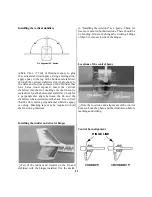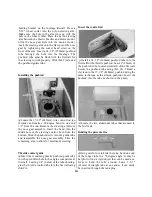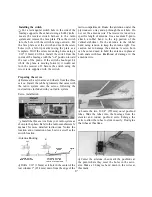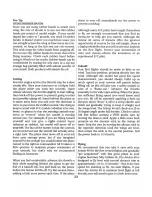
Your first flights should consist of mostly straight
and level flight with gentle turns to keep the model
over the field. These flights will give you practice at
coordinating your control inputs and maintaining
the proper orientation of the airplane. As
mentioned earlier, turns are accomplished by
banking the aircraft with the ailerons, then gently
adding some back stick (up elevator). Enough back
stick should be held in to keep the aircraft at a
constant altitude. To stop turning, apply opposite
aileron (or rudder) to level the wings, then release
the sticks. There is a memory aid that may help
keep you out of trouble when the plane is flying
toward you - "put the stick under the low wing." In
other words, move the stick in the direction of the
low wing to raise that wing. When you are
comfortable flying the aircraft, you can practice
using the rudder along with the ailerons to
"coordinate" the turns - usually, a small amount of
rudder applied in the direction of the turn will
keep the tail following in the exact same track as
the nose.
The most common mistake when learning to fly is
"over control." Think of pressure instead of large
movements of the control sticks. Remember all
Avistar 40's will recover from almost any over
control situation within 50 - 100 feet if you simply
let go of the sticks.
Add and practice one maneuver at a time, learning
how your Avistar 40 behaves in each maneuver.
After you have several flights on your Avistar 40, it's
time to reward yourself with your first acrobatic
maneuver - a loop. Climb to a safe altitude and
turn into the wind. Apply full throttle, level the
wings, then slowly pull back on the elevator stick to
about 1/2 to 3/4 up elevator (depending on your
throws) and hold this control input. After you go
over the top and start down the back side of the
loop, pull the throttle back to about half. This will
keep the stresses on the airplane low and the
airspeed relatively constant. Keep holding "up"
elevator until the plane is level, then slowly release
the sticks. You're done! It's really that easy!
CAUTION (THIS APPLIES TO ALL R/C
AIRPLANES): If, while flying, you notice any
unusual sounds, such as a low-pitched "buzz",
this may indicate control surface "flutter".
Because flutter can quickly destroy components
of your airplane, any time you detect flutter you
must immediately cut the throttle and land the
airplane! Check all servo grommets for
deterioration (this will indicate which surface
fluttered) and make sure all pushrod linkages
are slop-free. If it fluttered once, it will probably
flutter again under similar circumstances unless
you can eliminate the slop or flexing in the
linkages. Here are some things which can result
in flutter: Excessive hinge gap; Not mounting
control horns solidly; Sloppy fit of clevis pin in
horn; Elasticity present in flexible plastic
pushrods; Side-play of pushrod in guide tube
caused by tight bends; Sloppy fit of Z-bend in
servo arm; Insufficient glue used when gluing in
the elevator joiner wire or aileron torque rod;
Excessive flexing of aileron, caused by using too
soft balsa aileron; Excessive "play" or "backlash"
in servo gears; and Insecure servo mounting.
Landing
When it's time to land, fly a normal landing
pattern and approach as follows: Reduce the
power to about 1/4 and fly a downwind leg far
enough out from the runway to allow you to make
a gentle 180 degree turn. As you make the turn into
the wind for your final approach, pull the throttle
back to idle. The Avistar 40 has a lot of lift so you
will need a slow, reliable idle in order to achieve
a nice, slow landing. Allow the plane to keep
descending on a gradual glide slope until you are
about 3 feet off the runway. Gradually apply a little
up elevator to flare for landing. You should apply
just enough up elevator to hold the plane just off
the runway while the excess speed bleeds off. The
Avistar 40 should settle onto the runway for a slow,
slightly nose-high landing.
Good luck and have fun flying your Avistar 40, but
always stay in control and fly in a safe manner.

































